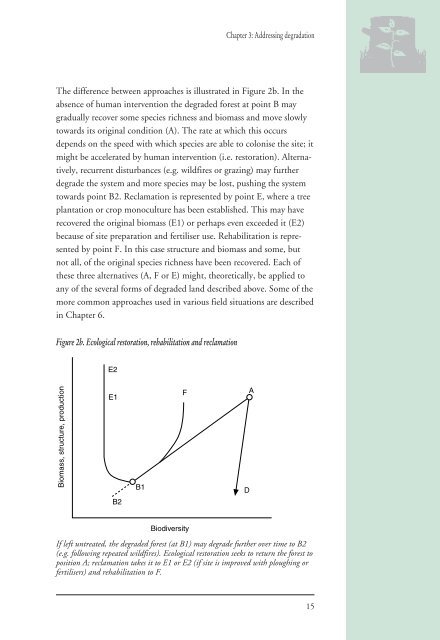Rehabilitation and Restoration Of Degraded Forests (PDF) - IUCN
Rehabilitation and Restoration Of Degraded Forests (PDF) - IUCN
Rehabilitation and Restoration Of Degraded Forests (PDF) - IUCN
Create successful ePaper yourself
Turn your PDF publications into a flip-book with our unique Google optimized e-Paper software.
Chapter 3: Addressing degradation<br />
The difference between approaches is illustrated in Figure 2b. In the<br />
absence of human intervention the degraded forest at point B may<br />
gradually recover some species richness <strong>and</strong> biomass <strong>and</strong> move slowly<br />
towards its original condition (A). The rate at which this occurs<br />
depends on the speed with which species are able to colonise the site; it<br />
might be accelerated by human intervention (i.e. restoration). Alternatively,<br />
recurrent disturbances (e.g. wildfires or grazing) may further<br />
degrade the system <strong>and</strong> more species may be lost, pushing the system<br />
towards point B2. Reclamation is represented by point E, where a tree<br />
plantation or crop monoculture has been established. This may have<br />
recovered the original biomass (E1) or perhaps even exceeded it (E2)<br />
because of site preparation <strong>and</strong> fertiliser use. <strong>Rehabilitation</strong> is represented<br />
by point F. In this case structure <strong>and</strong> biomass <strong>and</strong> some, but<br />
not all, of the original species richness have been recovered. Each of<br />
these three alternatives (A, F or E) might, theoretically, be applied to<br />
any of the several forms of degraded l<strong>and</strong> described above. Some of the<br />
more common approaches used in various field situations are described<br />
in Chapter 6.<br />
Figure 2b. Ecological restoration, rehabilitation <strong>and</strong> reclamation<br />
Biomass, structure, production<br />
E2<br />
E1<br />
B2<br />
B1<br />
F<br />
Biodiversity<br />
If left untreated, the degraded forest (at B1) may degrade further over time to B2<br />
(e.g. following repeated wildfires). Ecological restoration seeks to return the forest to<br />
position A; reclamation takes it to E1 or E2 (if site is improved with ploughing or<br />
fertilisers) <strong>and</strong> rehabilitation to F.<br />
D<br />
A<br />
15

















